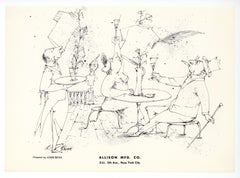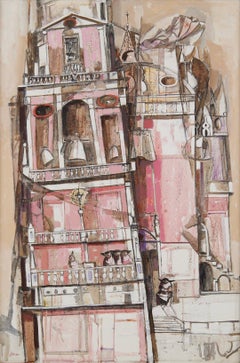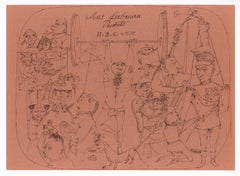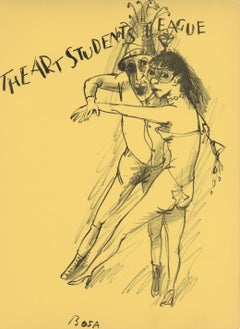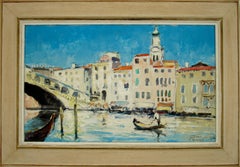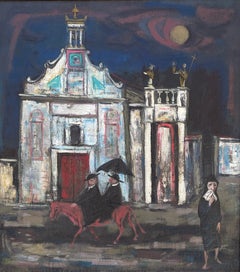Louis Bosa Art
Italian, 1905-1981
Born in Codroipo, a small village only a few miles from Venice, Italy in 1905, the son of a stonemason. Bosa emigrated to the U.S. at age 18 after studies at the Accademia della Belle Arti in Venice and became an American citizen. He then studied under John Sloan, of the Ashcan School, at the Art Students League in New York. A distinguished painter, Louis Bosa's work has been likened to that of artists ranging from Pieter Breughel the Elder to John Sloan and the Ashcan School.
Being an acute observer of the human condition, Bosa's paintings, which are primarily oil on canvas, often focus on people and street scenes from his native Italy. Bosa was known to have followed his subjects around, making many sketches and mental notes, and combined his observations in the final work to create visionary, fantastical images. The subjects of his paintings are highly stylized and expressionistic, and border on caricature. "People are so funny at times they are sad," he said: The people in his paintings are accessible and seem to portray human emotion and everyday life, conquering such concepts as mortality, humility and sometimes futility. His work often reveals comedy in the midst of tragedy. Many of his paintings include whimsical images of nuns riding bicycles and similar authority figures engaged in mundane activities.
He traveled extensively through Europe and often returned to his native Italy. Bosa painted for the Works Progress Administration and the Whitney Museum. He taught at the Cleveland Institute of Art, the New York Art Students League, the Parsons School of Design, Syracuse University, and the University of Notre Dame at South Bend, Indiana. His paintings and watercolors are on display at many well-known art studios and museums across the United States such as:
The Metropolitan Museum of Art - New York The Whitney Museum - New York
The Philadelphia Museum - Pennsylvania
The Worcester Museum - Massachusetts
The Springfield Museum - Massachusetts
The Toronto Art Museum - Canada
Notre Dame University Museum
The Butler Museum - Ohio
The Columbus Museum of Arts and Crafts - Ohio
The University of Illinois - Illinois
The Montclair Museum - New Jersey
The James A. Michener Art Museum - Doylestown, Pennsylvania
The Clearwater Museum - Florida
The Wilmington Museum - Delaware
The Athenian Museum - Connecticut
The Herron Art Institute - Indiana
The Rochester Museum - New York
The Delgado Museum - New Orleans
The Richmond Art Museum - Virginia
The Academy of Arts and Letters
The Hosanna Fund
The Encyclopedia Britannica Collections
International Business Machines
The Syracuse Museum - New York(Biography provided by WOLFS)
to
1
11
5
7
4
6
1
1
2
1
Overall Height
to
Overall Width
to
4
10
8
5
4
4
2
2
2
1
1
1
1
1
1
1
1
1
11
3
1
6
11
6,910
3,230
2,514
1,217
6
5
5
1
1
Artist: Louis Bosa
original lithograph
By Louis Bosa
Located in Henderson, NV
Medium: original lithograph. This lithograph was printed in 1955 for the "Improvisations" portfolio, and published by the Artists Equity Association of New York in an edition of 2000...
Category
1950s Louis Bosa Art
Materials
Lithograph
Two Wagons, Bucks County, PA 20th Century Farm Landscape
By Louis Bosa
Located in Beachwood, OH
Louis Bosa (American, 1905–1981)
Two Wagons, Bucks County, PA, 1934
Oil on canvas
Signed and dated lower right
20 x 24 inches
30 x 34 inches, framed
Born in Codroipo, a small villag...
Category
1930s Expressionist Louis Bosa Art
Materials
Oil
Cathedral in Venice, large 20th century oil painting, Italian-American artist
By Louis Bosa
Located in Beachwood, OH
Louis Bosa (American, 1905-1981)
Cathedral in Venice
Oil on canvas
Signed lower left
60.25 x 40.25 inches
66.5 x 46.5 inches, framed
Born in Codroipo, a small village only a few mi...
Category
Mid-20th Century Expressionist Louis Bosa Art
Materials
Oil
original lithograph
By Louis Bosa
Located in Henderson, NV
Medium: original lithograph. This lithograph was printed in 1956 for the "Improvisations" portfolio, published by the Artists Equity Association of New York on the occasion of the 19...
Category
1950s Louis Bosa Art
Materials
Lithograph
original lithograph
By Louis Bosa
Located in Henderson, NV
Medium: original lithograph. This lithograph is from the rare 1954 "Improvisations" portfolio, published by the Artists Equity Association of New York on the occasion of the 1954 Spr...
Category
1950s Louis Bosa Art
Materials
Lithograph
original lithograph
By Louis Bosa
Located in Henderson, NV
Medium: original lithograph. This lithograph is from the rare 1951 "Improvisations" portfolio, published by the Artists Equity Association of New York on the occasion of the 1951 Spr...
Category
1950s Louis Bosa Art
Materials
Lithograph
original lithograph
By Louis Bosa
Located in Henderson, NV
Medium: original lithograph. This lithograph is from the rare 1953 "Improvisations" portfolio, published by the Artists Equity Association of New York on the occasion of the 1953 Spr...
Category
1950s Louis Bosa Art
Materials
Lithograph
original lithograph
By Louis Bosa
Located in Henderson, NV
Medium: original lithograph. This lithograph is from the rare 1953 "Improvisations" portfolio, published by the Artists Equity Association of New York on the occasion of the 1953 Spr...
Category
1950s Louis Bosa Art
Materials
Lithograph
Industrial Railroad WPA Mid 20th Century American Scene Rural Modern Realism
By Louis Bosa
Located in New York, NY
Industrial Railroad WPA Mid 20th Century American Scene Rural Modern Realism
Large oil on canvas genre painting depicting laborers working on a railroad, with rural landscape in the...
Category
1940s American Realist Louis Bosa Art
Materials
Canvas, Oil
20th Century Bucks County Colorful Landscape Painting, Italian artist
By Louis Bosa
Located in Beachwood, OH
Louis Bosa (American, 1905–1981)
Bucks County, 1934
Oil on canvas
Signed and dated lower right
17.5 x 21.5 inches
25.5 x 29 inches, framed
Born in Codroipo, a small village only a f...
Category
1930s Expressionist Louis Bosa Art
Materials
Oil
20th century painting of monks in Venice, Italian pink figural work
By Louis Bosa
Located in Beachwood, OH
Louis Bosa (Italian-American, 1905–1981)
Island of the Monks, c. 1930
Oil on masonite
Signed lower right
14 x 24 inches
23 x 33 inches, framed
Born in Codroipo, a small village only...
Category
1930s Expressionist Louis Bosa Art
Materials
Oil
Related Items
Forgive Us Our Trespasses by Banksy
By Banksy
Located in London, GB
Offset lithograph on paper
Size: 41,9 x 59cm, folded.
Description: Official lithograph produced by Banksy. Plate signed lower right.
Category
2010s Street Art Louis Bosa Art
Materials
Paper, Lithograph
Gerhard Cohn Roemers (1900-1965) - Ponte Del Rialto Venice Italy – Oil Painting
By Gerhard Cohn Roemers
Located in Meinisberg, CH
Gerhard Cohn Roemers
(German, 1900 - 1965)
Ponte Del Rialto in Venice
• Oil on canvas, ca. 40 x 65 cm
• Frame, ca. 57 x 82 cm
• Signed and titled lower right corner
Gerhard Cohn Ro...
Category
Mid-20th Century Expressionist Louis Bosa Art
Materials
Canvas, Oil
Free Shipping
H 22.45 in W 32.29 in D 1.19 in
Dog 43 by David Hockney
By David Hockney
Located in London, GB
Offset Lithograph
Edition of Unknown Size
20.87 x 25.20 in
53.0 x 64.0 cm
This is an original vintage David Hockney poster - it is not a later reproduction.
Also available as a s...
Category
1990s Contemporary Louis Bosa Art
Materials
Lithograph
Romanian Israeli Modernist Oil Painting Expressionist Figures Mothers and Babies
By Risa Propst Kraid
Located in Surfside, FL
Risa Propst Kraid (Romanian - Israeli, 1894-1983) Jewish Israeli Woman artist. enigmatic picture of either women picnicking or refugees huddling together.
Painting and Sculpture We...
Category
1960s Expressionist Louis Bosa Art
Materials
Canvas, Oil
Dancing in the rain 60X30 oil, Valentine’s Day gifts art
Located in Zofingen, AG
In this vibrant oil painting, I've captured the essence of unbridled joy and carefree abandon. Two figures dance beneath a crimson umbrella, their movements a blend of expressionism ...
Category
2010s Expressionist Louis Bosa Art
Materials
Oil, Canvas
H 23.63 in W 11.82 in D 0.79 in
Figurative Portrait in the Style of Ramiro Arrue, The Gypsy Caravan
By Ramiro Arrue
Located in Cotignac, FR
Figurative Expressionist portrait and scene of a travellers gypsy caravan. The painting is signed bottom right, Fayo (?) but further research is necessary for an attribution. Presented in a fine chip carved Montparnasse frame.
Provenance: from a Private French collection, South of France.
A strong and powerful scene, part portrait part scene of a travellers life. Both characters seem to be in quiet contemplation aware of each other but not looking. The artist has created a mood to the painting featuring simple lines with an almost monumental quality and muted colour harmonies. The work is very reminiscent of the paintings of Ramiro Arrue and the scenes of his beloved Basque country.
Ramiro Arrue was born in Bilbao, into an artistic family: his three older brothers, Alberto, Ricardo, and José, were also artists and frequently held joint exhibitions with him. He also had two sisters. Their father, Lucas Arrue, was an art collector who sold his collections (including a Goya) to pay for the artistic training of his sons. At the age of nineteen, Ramiro travelled to Paris to take courses at the Académie de la Grande Chaumière. Living in Montparnasse, he became an associate of his countrymen Ignacio Zuloaga and Paco Durrio, as well as the sculptor Antoine Bourdelle, who became a close friend. He was also associated with Picasso, Modigliani, and Jean Cocteau. In 1911, Arrue exhibited at the Salon des Artistes Français.
In 1922, along with his friends Philip Veyrin and Commandant William Boissel, he founded the Musée Basque at Bayonne.
In 1925 Arrue won a gold medal at the Exposition Internationale des Arts Decoratifs. He exhibited in Bayonne, Pau, Strasbourg, Bilbao, and Cordoba. Along with his brother José, he travelled and exhibited in South America, to Buenos Aires and Montevideo. He often, however, returned to the Basque Country, particularly to Saint-Jean-de-Luz, where he settled in 1917 and where he found his main inspiration for landscapes, portraits, and everyday scenes. In 1929, he married Suzanne: they went on honeymoon in St. Tropez.
Arrue produced illustrations for Francis Jammes (La Noce basque), Pierre Loti (Ramuntcho), Joseph Peyré (Jean le basque...
Category
Mid-20th Century Expressionist Louis Bosa Art
Materials
Oil, Board
H 30.71 in W 26.38 in D 1.58 in
Soulmate Modern Figurative Oil Painting by Ukranian Artist Dasha Pogodina
Located in Zofingen, AG
Participant SOLO EXHIBITION in Thun, Switzerland "Strength, and Vulnerability" December 2022. Please get in touch with us if you have any questions about this artwork.
MATERIALS:
Th...
Category
2010s Expressionist Louis Bosa Art
Materials
Oil, Canvas
H 37.41 in W 45.28 in D 0.79 in
Large Expressionist Oil on Canvas, Apartment Interior and Cityscape.
By Ernst Ludwig Kirchner
Located in Cotignac, FR
A mid century Expressionist oil on canvas of a man, child and cat in an interior with a cityscape beyond. The work is not signed but there are various notations to the top rear stret...
Category
Mid-20th Century Expressionist Louis Bosa Art
Materials
Oil, Canvas
Circle of Chaïm Soutine, Expressionist painting of Fishermen in a French harbour
Located in Harkstead, GB
A very stylish image of a French harbour. Painted with great panache - wonderful brushwork and a vivid palette, reminiscent of the work of Chaim Soutine
Circle of Chaïm Soutine (189...
Category
20th Century Expressionist Louis Bosa Art
Materials
Board, Oil
H 14.5 in W 18 in D 1 in
Tableau, Japanese, limited edition lithograph, black, white, red, signed, number
By Toko Shinoda
Located in Santa Fe, NM
Tableau, Japanese, limited edition lithograph, black, white, red, signed, number
Shinoda's works have been collected by public galleries and museums, including the Museum of Modern Art, Solomon R. Guggenheim Museum, Brooklyn Museum and Metropolitan Museum (all in New York City), the National Museum of Modern Art in Tokyo, the British Museum in London, the Art Institute of Chicago, Arthur M. Sackler Gallery of the Smithsonian in Washington, D.C., the Singapore Art Museum, the National Museum of Singapore, the Kröller-Müller Museum in Otterlo, Netherlands, the Albright–Knox Art Gallery in Buffalo, New York, the Cincinnati Art Museum, and the Yale University Art Gallery in New Haven, Connecticut.
New York Times Obituary, March 3, 2021 by Margalit Fox, Alex Traub contributed reporting.
Toko Shinoda, one of the foremost Japanese artists of the 20th century, whose work married the ancient serenity of calligraphy with the modernist urgency of Abstract Expressionism, died on Monday at a hospital in Tokyo. She was 107.
Her death was announced by her gallerist in the United States.
A painter and printmaker, Ms. Shinoda attained international renown at midcentury and remained sought after by major museums and galleries worldwide for more than five decades.
Her work has been exhibited at, among other places, the Metropolitan Museum of Art and the Museum of Modern Art in New York; the Art Institute of Chicago; the British Museum; and the National Museum of Modern Art in Tokyo. Private collectors include the Japanese imperial family.
Writing about a 1998 exhibition of Ms. Shinoda’s work at a London gallery, the British newspaper The Independent called it “elegant, minimal and very, very composed,” adding, “Her roots as a calligrapher are clear, as are her connections with American art of the 1950s, but she is quite obviously a major artist in her own right.”
As a painter, Ms. Shinoda worked primarily in sumi ink, a solid form of ink, made from soot pressed into sticks, that has been used in Asia for centuries.
Rubbed on a wet stone to release their pigment, the sticks yield a subtle ink that, because it is quickly imbibed by paper, is strikingly ephemeral. The sumi artist must make each brush stroke with all due deliberation, as the nature of the medium precludes the possibility of reworking even a single line.
“The color of the ink which is produced by this method is a very delicate one,” Ms. Shinoda told The Business Times of Singapore in 2014. “It is thus necessary to finish one’s work very quickly. So the composition must be determined in my mind before I pick up the brush. Then, as they say, the painting just falls off the brush.”
Ms. Shinoda painted almost entirely in gradations of black, with occasional sepias and filmy blues. The ink sticks she used had been made for the great sumi artists of the past, some as long as 500 years ago.
Her line — fluid, elegant, impeccably placed — owed much to calligraphy. She had been rigorously trained in that discipline from the time she was a child, but she had begun to push against its confines when she was still very young.
Deeply influenced by American Abstract Expressionists like Jackson Pollock, Mark Rothko and Robert Motherwell, whose work she encountered when she lived in New York in the late 1950s, Ms. Shinoda shunned representation.
“If I have a definite idea, why paint it?,” she asked in an interview with United Press International in 1980. “It’s already understood and accepted. A stand of bamboo is more beautiful than a painting could be. Mount Fuji is more striking than any possible imitation.”
Spare and quietly powerful, making abundant use of white space, Ms. Shinoda’s paintings are done on traditional Chinese and Japanese papers, or on backgrounds of gold, silver or platinum leaf.
Often asymmetrical, they can overlay a stark geometric shape with the barest calligraphic strokes. The combined effect appears to catch and hold something evanescent — “as elusive as the memory of a pleasant scent or the movement of wind,” as she said in a 1996 interview.
Ms. Shinoda’s work also included lithographs; three-dimensional pieces of wood and other materials; and murals in public spaces, including a series made for the Zojoji Temple in Tokyo.
The fifth of seven children of a prosperous family, Ms. Shinoda was born on March 28, 1913, in Dalian, in Manchuria, where her father, Raijiro, managed a tobacco plant. Her mother, Joko, was a homemaker. The family returned to Japan when she was a baby, settling in Gifu, midway between Kyoto and Tokyo.
One of her father’s uncles, a sculptor and calligrapher, had been an official seal carver to the Meiji emperor. He conveyed his love of art and poetry to Toko’s father, who in turn passed it to Toko.
“My upbringing was a very traditional one, with relatives living with my parents,” she said in the U.P.I. interview. “In a scholarly atmosphere, I grew up knowing I wanted to make these things, to be an artist.”
She began studying calligraphy at 6, learning, hour by hour, impeccable mastery over line. But by the time she was a teenager, she had begun to seek an artistic outlet that she felt calligraphy, with its centuries-old conventions, could not afford.
“I got tired of it and decided to try my own style,” Ms. Shinoda told Time magazine in 1983. “My father always scolded me for being naughty and departing from the traditional way, but I had to do it.”
Moving to Tokyo as a young adult, Ms. Shinoda became celebrated throughout Japan as one of the country’s finest living calligraphers, at the time a signal honor for a woman. She had her first solo show in 1940, at a Tokyo gallery.
During World War II, when she forsook the city for the countryside near Mount Fuji, she earned her living as a calligrapher, but by the mid-1940s she had started experimenting with abstraction. In 1954 she began to achieve renown outside Japan with her inclusion in an exhibition of Japanese calligraphy at MoMA.
In 1956, she traveled to New York. At the time, unmarried Japanese women could obtain only three-month visas for travel abroad, but through zealous renewals, Ms. Shinoda managed to remain for two years.
She met many of the titans of Abstract Expressionism there, and she became captivated by their work.
“When I was in New York in the ’50s, I was often included in activities with those artists, people like Mark Rothko, Jackson Pollock, Motherwell and so forth,” she said in a 1998 interview with The Business Times. “They were very generous people, and I was often invited to visit their studios, where we would share ideas and opinions on our work. It was a great experience being together with people who shared common feelings.”
During this period, Ms. Shinoda’s work was sold in the United States by Betty Parsons, the New York dealer who represented Pollock, Rothko and many of their contemporaries.
Returning to Japan, Ms. Shinoda began to fuse calligraphy and the Expressionist aesthetic in earnest. The result was, in the words of The Plain Dealer of Cleveland in 1997, “an art of elegant simplicity and high drama.”
Among Ms. Shinoda’s many honors, she was depicted, in 2016, on a Japanese postage stamp. She is the only Japanese artist to be so honored during her lifetime.
No immediate family members survive.
When she was quite young and determined to pursue a life making art, Ms. Shinoda made the decision to forgo the path that seemed foreordained for women of her generation.
“I never married and have no children,” she told The Japan Times in 2017. “And I suppose that it sounds strange to think that my paintings are in place of them — of course they are not the same thing at all. But I do say, when paintings that I have made years ago are brought back into my consciousness, it seems like an old friend, or even a part of me, has come back to see me.”
Works of a Woman's Hand
Toko Shinoda bases new abstractions on ancient calligraphy
Down a winding side street in the Aoyama district, western Tokyo. into a chunky white apartment building, then up in an elevator small enough to make a handful of Western passengers friends or enemies for life. At the end of a hall on the fourth floor, to the right, stands a plain brown door. To be admitted is to go through the looking glass. Sayonara today. Hello (Konichiwa) yesterday and tomorrow.
Toko Shinoda, 70, lives and works here. She can be, when she chooses, on e of Japans foremost calligraphers, master of an intricate manner of writing that traces its lines back some 3,000 years to ancient China. She is also an avant-garde artist of international renown, whose abstract paintings and lithographs rest in museums around the world. These diverse talents do not seem to belong in the same epoch. Yet they have somehow converged in this diminutive woman who appears in her tiny foyer, offering slippers and ritual bows of greeting.
She looks like someone too proper to chip a teacup, never mind revolutionize an old and hallowed art form She wears a blue and white kimono of her own design. Its patterns, she explains, are from Edo, meaning the period of the Tokugawa shoguns, before her city was renamed Tokyo in 1868. Her black hair is pulled back from her face, which is virtually free of lines and wrinkles. except for the gold-rimmed spectacles perched low on her nose (this visionary is apparently nearsighted). Shinoda could have stepped directly from a 19th century Meji print.
Her surroundings convey a similar sense of old aesthetics, a retreat in the midst of a modern, frenetic city. The noise of the heavy traffic on a nearby elevated highway sounds at this height like distant surf. delicate bamboo shades filter the daylight. The color arrangement is restful: low ceilings of exposed wood, off-white walls, pastel rugs of blue, green and gray.
It all feels so quintessentially Japanese that Shinoda’s opening remarks come as a surprise. She points out (through a translator) that she was not born in Japan at all but in Darien, Manchuria. Her father had been posted there to manage a tobacco company under the aegis of the occupying Japanese forces, which seized the region from Russia in 1905. She says,”People born in foreign places are very free in their thinking, not restricted” But since her family went back to Japan in 1915, when she was two, she could hardly remember much about a liberated childhood? She answers,”I think that if my mother had remained in Japan, she would have been an ordinary Japanese housewife. Going to Manchuria, she was able to assert her own personality, and that left its mark on me.”
Evidently so. She wears her obi low on the hips, masculine style. The Porcelain aloofness she displays in photographs shatters in person. Her speech is forceful, her expression animated and her laugh both throaty and infectious. The hand she brings to her mouth to cover her amusement (a traditional female gesture of modesty) does not stand a chance.
Her father also made a strong impression on the fifth of his seven children:”He came from a very old family, and he was quite strict in some ways and quite liberal in others.” He owned one of the first three bicycles ever imported to Japan and tinkered with it constantly He also decided that his little daughter would undergo rigorous training in a procrustean antiquity.
“I was forced to study from age six on to learn calligraphy,” Shinoda says, The young girl dutifully memorized and copied the accepted models. In one sense, her father had pushed her in a promising direction, one of the few professional fields in Japan open to females. Included among the ancient terms that had evolved around calligraphy was onnade, or woman's writing.
Heresy lay ahead. By the time she was 15, she had already been through nine years of intensive discipline, “I got tired of it and decided to try my own style. My father always scolded me for being naughty and departing from the traditional way, but I had to do it.”
She produces a brush and a piece of paper to demonstrate the nature of her rebellion. “This is kawa, the accepted calligraphic character for river,” she says, deftly sketching three short vertical strokes. “But I wanted to use more than three lines to show the force of the river.” Her brush flows across the white page, leaving a recognizable river behind, also flowing.” The simple kawa in the traditional language was not enough for me. I wanted to find a new symbol to express the word river.”
Her conviction grew that ink could convey the ineffable, the feeling, "as she says, of wind blowing softly.” Another demonstration. She goes to the sliding wooden door of an anteroom and disappears in back of it; the only trace of her is a triangular swatch of the right sleeve of her kimono, which she has arranged for that purpose. A realization dawns. The task of this artist is to paint that three sided pattern so that the invisible woman attached to it will be manifest to all viewers.
Gen, painted especially for TIME, shows Shinoda’s theory in practice. She calls the work “my conception of Japan in visual terms.” A dark swath at the left, punctuated by red, stands for history. In the center sits a Chinese character gen, which means in the present or actuality. A blank pattern at the right suggests an unknown future.
Once out of school, Shinoda struck off on a path significantly at odds with her culture. She recognized marriage for what it could mean to her career (“a restriction”) and decided against it. There was a living to be earned by doing traditional calligraphy:she used her free time to paint her variations. In 1940 a Tokyo gallery exhibited her work. (Fourteen years would pass before she got a second show.)War came, and bad times for nearly everyone, including the aspiring artist , who retreated to a rural area near Mount Fuji and traded her kimonos for eggs.
In 1954 Shinoda’s work was included in a group exhibit at New York City’s Museum of Modern Art. Two years later, she overcame bureaucratic obstacles to visit the U.S.. Unmarried Japanese women are allowed visas for only three months, patiently applying for two-month extensions, one at a time, Shinoda managed to travel the country for two years. She pulls out a scrapbook from this period. Leafing through it, she suddenly raises a hand and touches her cheek:”How young I looked!” An inspection is called for. The woman in the grainy, yellowing newspaper photograph could easily be the on e sitting in this room. Told this, she nods and smiles. No translation necessary.
Her sojourn in the U.S. proved to be crucial in the recognition and development of Shinoda’s art. Celebrities such as actor Charles Laughton and John Lewis of the Modern Jazz Quartet bought her paintings and spread the good word. She also saw the works of the abstract expressionists, then the rage of the New York City art world, and realized that these Western artists, coming out of an utterly different tradition, were struggling toward the same goal that had obsessed her. Once she was back home, her work slowly made her famous.
Although Shinoda has used many materials (fabric, stainless steel, ceramics, cement), brush and ink remain her principal means of expression. She had said, “As long as I am devoted to the creation of new forms, I can draw even with muddy water.” Fortunately, she does not have to. She points with evident pride to her ink stone, a velvety black slab of rock, with an indented basin, that is roughly a foot across and two feet long. It is more than 300 years old. Every working morning, Shinoda pours about a third of a pint of water into it, then selects an ink stick from her extensive collection, some dating back to China’s Ming dynasty. Pressing stick against stone, she begins rubbing. Slowly, the dried ink dissolves in the water and becomes ready for the brush. So two batches of sumi (India ink) are exactly alike; something old, something new. She uses color sparingly. Her clear preference is black and all its gradations. “In some paintings, sumi expresses blue better than blue.”
It is time to go downstairs to the living quarters. A niece, divorced and her daughter,10,stay here with Shinoda; the artist who felt forced to renounce family and domesticity at the outset of her career seems welcome to it now. Sake is offered, poured into small cedar boxes and happily accepted. Hold carefully. Drink from a corner. Ambrosial. And just right for the surroundings and the hostess. A conservative renegade; a liberal traditionalist; a woman steeped in the male-dominated conventions that she consistently opposed. Her trail blazing accomplishments are analogous to Picasso’s.
When she says goodbye, she bows. --by Paul Gray...
Category
1990s Contemporary Louis Bosa Art
Materials
Lithograph
Cat Friends
By Leonor Fini
Located in Columbia, MO
LEONOR FINI
Cat Friends
1973
Color lithograph
Ed. 157/230
12.5 x 9 inches
Category
1970s Surrealist Louis Bosa Art
Materials
Lithograph
Full Length Mirror
Located in Columbia, MO
Full Length Mirror
Lithograph 16/20
14 x 10 inches
Framed: 22 x 18 inches
Category
21st Century and Contemporary Contemporary Louis Bosa Art
Materials
Lithograph
Previously Available Items
An Evening Prayer, Italian church scene with nun and priests
By Louis Bosa
Located in Beachwood, OH
Louis Bosa (American, 1905-1981)
An Evening Prayer
Oil on canvas
Signed lower left, titled verso
20.5 x 18 inches
29.75 x 27.75 inches, framed
Provenance:
Kleemann Galleries, New Y...
Category
20th Century Expressionist Louis Bosa Art
Materials
Oil
House on Canal, American Landscape with Bridge and Figures, Watercolor on Paper
By Louis Bosa
Located in Doylestown, PA
"House on Canal" is a 11" x 16", watercolor on paper landscape by Italian born artist Louis Bosa. This painting is matted and framed. Provenance: Casa Bosa Galleria, Private Collecti...
Category
20th Century Modern Louis Bosa Art
Materials
Watercolor, Archival Paper
H 21.5 in W 25.5 in D 2.5 in
Louis Bosa art for sale on 1stDibs.
Find a wide variety of authentic Louis Bosa art available for sale on 1stDibs. You can also browse by medium to find art by Louis Bosa in oil paint, paint, lithograph and more. Much of the original work by this artist or collective was created during the 20th century and is mostly associated with the Expressionist style. Not every interior allows for large Louis Bosa art, so small editions measuring 9 inches across are available. Customers who are interested in this artist might also find the work of Edgardo Corbelli, Edouard Goerg, and Giulio da Milano. Louis Bosa art prices can differ depending upon medium, time period and other attributes. On 1stDibs, the price for these items starts at $50 and tops out at $15,000, while the average work can sell for $3,250.
